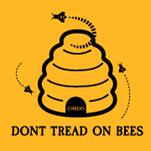Ban bee-killing pesticides
Due to the use of bee-killing neonicotinoid pesticides, Bees and other pollinators are dying-off at an alarming rate with dire implications for our food supply and domestic agriculture industry.
The federal government’s response to this crisis has been totally inadequate – but that could soon change.
In June, President Obama created the Pollinator Health Task Force with the goal of focusing federal efforts to research, prevent, and recover from pollinator losses.1
Now, for the first time, the Pollinator Health Task Force is accepting public comments on what it should do to protect bees and other pollinators.2We know a ban on bee-killing neonicotinoid pesticides is what’s needed to save the bees, but we only have a few days to pressure the task force to act before this crucial public comment period closes.
Tell the Pollinator Health Task Force: Ban bee-killing neonicotinoid pesticides. Submit a public comment before the November 24 deadline.
Bees and other pollinators play a vital role in our food production system by enabling the production of many of the nuts, fruits and vegetables in our diets. In total, pollinators make possible an astounding 35% of global food production and contribute more than $24 billion annually to the U.S. economy. But the number of managed honeybee colonies in the United States has declined from 6 million in the 1940s to just 2.5 million today – jeopardizing our food supply and domestic agriculture industry.3
Having healthy, growing honey bee and native pollinator populations will help to produce abundant food resources for our wildlife during the winter. Just like increased pollination from honey bees creates more apples in an orchard, it will also create more of the seeds that wildlife will be foraging on this winter. Making the connection between supporting healthy pollinator populations and helping get more wildlife through the winter in better physical condition!
That’s why President Obama tasked the Secretary of Agriculture and the Administrator of the Environmental Protection Agency with co-chairing the Pollinator Health Task Force and leading the federal response to the devastating decline in populations of bees and other vital pollinators.
So far, both the USDA and EPA have displayed a disturbing lack of urgency when it comes to saving bees from deadly pesticides. In fact, the EPA’s current plan is to continue studying neonicotinoid pesticides until 2018 before it takes action to save our pollinators.4
We can’t afford to wait four more years to do what’s necessary to save bees from deadly pesticides. With the White House paying attention to the issue and the Pollinator Health Task Force soliciting public input, now is the time to demand an immediate ban on bee-killing neonicotinoid pesticides.
Tell the Pollinator Health Task Force: Save the bees by banning neonicotinoid pesticides. Submit a public comment before the November 24 deadline.
Go to the Credo Action page and fill out your public comments today. Thanks. http://act.credoaction.com/sign/ban_neonics?nosig=1&t=1&akid=12199.1767730.Afwozp

